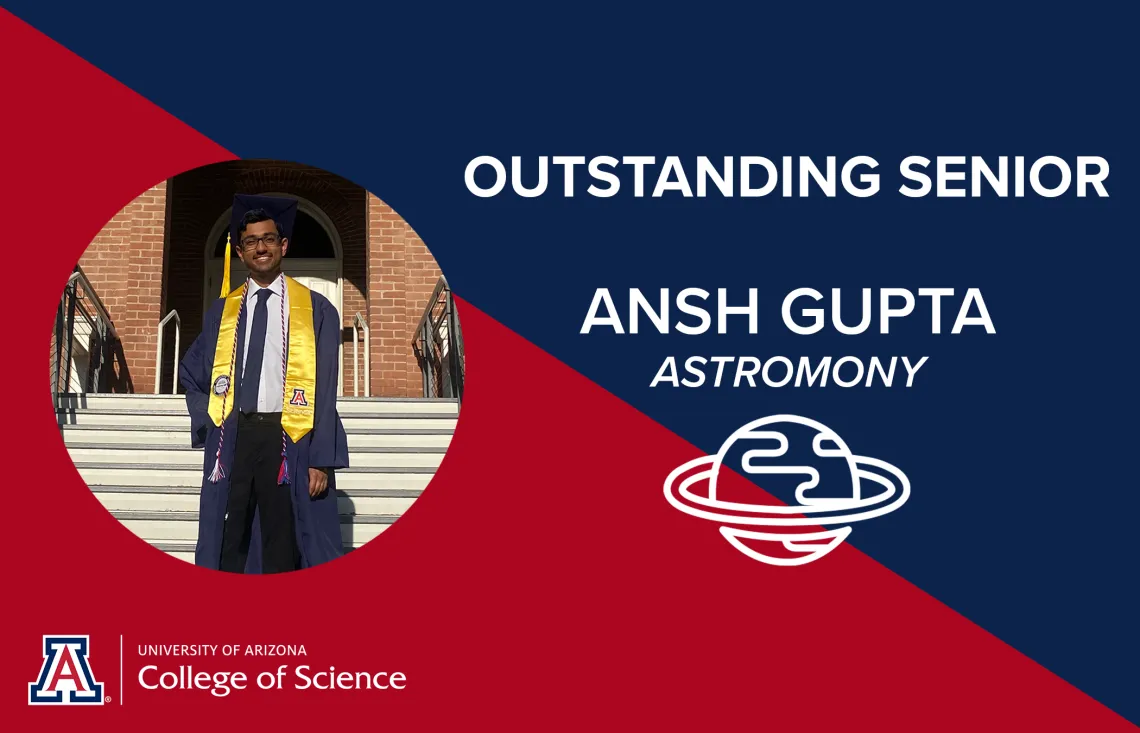Outstanding Seniors in the College of Science: Ansh Gupta

This spring, each department in the University of Arizona's College of Science nominated an outstanding senior who went above and beyond during their time as a Wildcat. We are pleased to share their stories as they reflect on their time at UArizona. Our final Outstanding Senior is Ansh Gupta in the Department of Astronomy. Ansh was also named the overall Outstanding Senior in the College of Science.
Ansh Gupta
Department: Astronomy
College of Science: Why did you choose your area of study?
Gupta: I’ve loved astronomy for as long as I can remember, and I voraciously consumed books about space as a kid. My freshman year of high school was also the year of the “Great American Eclipse” in 2017. Coincidentally, the path of totality ran right through our town, and we were projected to draw in hundreds of thousands of visitors. I excitedly looked to join a local astronomy club to celebrate and experience the event with others, only to find that there wasn’t one. I decided to form my own club, and I gave informational presentations about the upcoming eclipse at my local library. The response was positive, so I decided to continue giving monthly lectures about a variety of topics surrounding space and astronomy. This experience deepened my passion for astronomy and also inspired me to continue pursuing science outreach throughout my undergraduate career and beyond.
COS: Tell us about a class or research project you really enjoyed.
Gupta: I’m searching for some of the most extreme objects in the Universe, called quasars. With Dr. Xiaohui Fan and Dr. Jinyi Yang, I have worked to uncover information about the formation and evolution of quasars and their relationship with their host galaxies.
Nearly all galaxies have a massive black hole at their center. Quasars are thought to be supermassive black holes surrounded by an extremely hot disk of gas and dust. The disk's glow can outshine its entire host galaxy, which can have trillions of stars. Light from distant objects can take eons to reach us, meaning that seeing far is equivalent to seeing back in time. These cosmic monsters are bright enough to see at mind-boggling distances, allowing astronomers to catch glimpses of conditions in the early Universe.
Using data from public surveys, our team identified quasar candidates. I used data from the Dark Energy Spectroscopic Instrument (DESI) to confirm that these objects were indeed quasars. The DESI survey is looking at millions of objects, splitting their light up into their component colors, or "spectra". By combing through thousands of "spectra", I determined which of the candidates were truly quasars and measured their distances away from us. The candidates I confirmed expanded the known sample of quasars within the first 1.25 billion years of the universe’s lifetime by nearly 50%.
COS: What is one specific memory from your time at UA that you'll cherish forever?
Gupta: Some of the most fun I've had as an undergrad has been on stargazing trips with the UA Astronomy Club. We regularly organize trips to amazing sites like Sabino Canyon and Windy Point on Mount Lemmon. It can be easy to forget why we're studying astronomy as we get buried in equations and code. Attending these events and getting to see the most astounding views the night sky has to offer is a breathtaking reminder of why I love astronony. One of my absolute favorite sights is at Windy Point, where at the right time of year you can see the Milky Way splayed out across the sky opposite the sparkling city lights of Tucson. It's one of the most paradoxial sights I have ever witnessed, but a truly beautiful show of humanity's connection with the cosmos.
COS: What is next for you after graduation?
Gupta: In the fall of 2024, I will be joining the astronomy graduate program at The University of Texas at Austin. I hope to answer key mysteries of the early universe using cutting-edge observatories like the James Webb Space Telescope.

